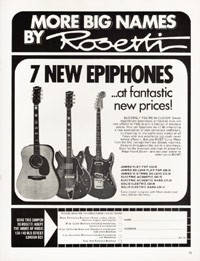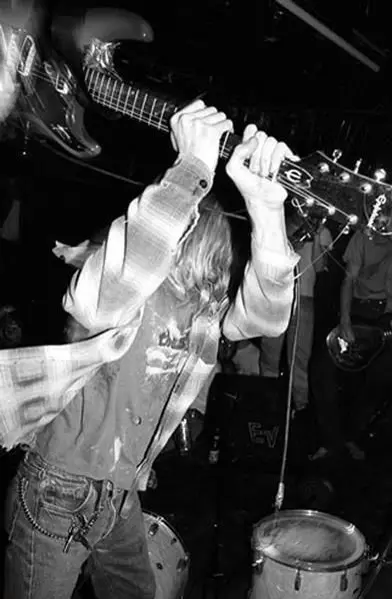
The Epiphone 1802T or ET-270 was a vaguely Strat-styled offset solid-body guitar with distinctive cherry red finish, and produced at the Japanese Matsumoku factory, alongside a number of other guitars that would make up the new Epiphone range for 1970. Production lasted approximately four years, from mid-1970 until mid/late 1974. The model (and hence name) derived from an existing guitar, the Aria 1802T (available since at least 1968) sharing the same body shape - but with a Fender-style, single-side headstock. This guitar was also rebadged and exported to other distributors worldwide with brand/models such as: Conrad, Eros 9525, Luxor 1803T, Lyle 1802T, Tempo, Toledo 18021. Some very early examples of the Epiphone 1802T were also built like this, before settling on a more traditional two-sided headstock in late 1970 or early 1971. Have a look at en early Fender-headstock ET-270 in the 1970 Rosetti Epiphone catalogue (UK).
Since the mid-1950s Epiphone guitars had been effectively identical to Gibson guitars; both were built side by side at same same Kalamazoo plant in the USA using the same components, materials, techniques and labour pool. Consequently both had much the same price. But with an onslaught of cheap but generally good quality guitars coming from places like Italy and Japan, Epiphone were persuaded to introduce imported guitars of their own. And in October of 1970 Japanese-made Epiphone guitars were included in company price lists for the first time. Other models included an electric acoustic guitar, the 5120T and a solid body bass companion to the 1802T, the 1820.

The Epiphone 1802T was described as follows in the 1971 Pick Epiphone brochure:
Modern deep cutaway design provides easy action and access to all frets. Response is from deep, rumbling bass sounds to treble biting tones. Features: thin modern cutaway design, high gloss cherry red finish. Slim, fast, low-action three-piece adjustable neck, two powerful pickups with adjustable polepieces, pickup selector switch, rosewood fingerboard with pearl dot inlays, hand vibrola, chrome plated parts. 13 1/4" wide, 17 1/4" long, 1 3/8" thin; 24 3/4" scale, 21 frets.
The Epiphone 1802T was renamed as the Epiphone ET-270 in late 1971. It is this name that this model is more generally known.
Now the Matsumoku plant had been producing guitars for worldwide distribution for some time, and the design that would ultimately become the Epiphone ET-270 had been available since at least the end of 1966 - certainly as the Aria 1802T, Domino Olympic DC202 (distributed in the USA by Maurice Lipsky), and perhaps a little later as the Eros 9525 (distributed in the UK by Rosetti). All of these guitars had their own variations in hardware, ornamentation etc, but were essentially the same instrument. One feature common to all was the Fender-style one-sided headstock. The very earliest batch of Epiphone 1802T guitars (presumably shipped in mid-late 1970) also had this neck, and although these models are not shown in the US literature of the time, UK distributor Rosetti did produce a brochure showing both the 1802T guitar and 1820 bass with a one-sided headstock. Compare the 1802T headstock in the two adverts below, from November 1970 and February 1971.
Electric guitar advertisements originally published from 1970 onwards. Click on the images for larger copies. Check out other vintage Rosetti advertisements

Rosetti ET-270 - 7 New Epiphones At Fantastic New Prices (1970)
November 1970. More big names by Rosetti. Production of Epiphones moved from America to Japan in 1969/70, in an attempt to save costs and reduce prices in a marketplace being bombarded with oversea...
[more]

Rosetti ET-270 - 7 New Epiphones At Fantastic New Prices (1971)
This British Epiphone advertisement was posted by UK-distributor Rosetti in February 1971. It features three of seven new Japanese models available from late 1970. The image shows the 6830 Jumbo ac...
[more]
As mentioned, Rosetti previously marketed effectively the same model as the Eros 9525, and one catalogue from late 1970/early 1971 includes images of both the Eros and the Epiphone (though the Eros is marked discontinued). Around the same time frame, the guitar was also sold as Conrad (David Wexler), Electra Sustainer 2263, Granada, Luxor (Otto-Manfred Hack), Lyle (L.D Heater), Tempo (Merson) and Toledo. In 1973 Gretsch also distributed their version - like the Epiphone with a two sided headstock - as the Dorado 5985.

There are not many high profile ET-270 users, but surely the best known is Kurt Cobain who used the guitar briefly but to great effect. In fact Cobain only owned the guitar for four months, but used it widely in this time both live and in the studio, before ultimately destroying it at a show at the Pyramid Club in New York. 26th April 1990.
$1400
$175
$549
$1200
£823
C $1400
£415